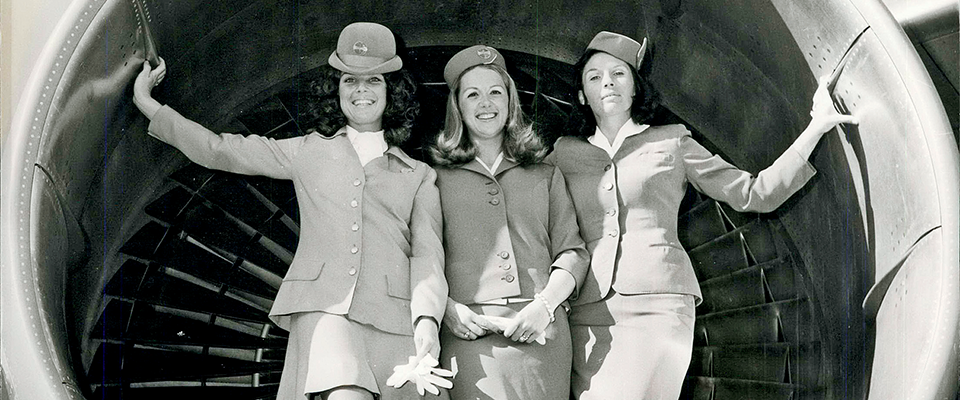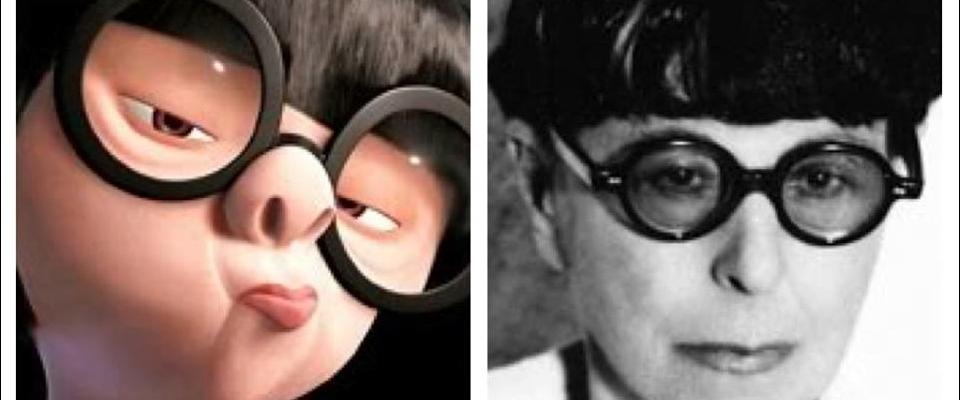Everything changed when women got wings.
HOLLY BOROWIAK-ROGERS STILL REMEMBERS the flyer pasted up on campus: “You want to travel? Call this number.” It was 1970, and she would soon see her four years at Cal come to an unceremonious end—literally. After National Guardsmen gunned down four students at Kent State, Berkeley administrators had canceled graduation.
A journalism major, Borowiak-Rogers (Borowiak before marriage) was unsure of what came next for her. She had a summer internship lined up in Washington, D.C., and an invitation to cut sugarcane in Cuba with her then-boyfriend (and later Green Party candidate), Peter Camejo, a student-activist who had the distinction of being on Gov. Ronald Reagan’s list of the “ten most dangerous Californians.” Just a few weeks before he was set to graduate, Berkeley expelled Camejo for the “unauthorized use of a microphone.”
A decade earlier, solitary international travel was rarely undertaken by a woman who could not leverage high social status to excuse her lack of a chaperone.
Craving adventures of her own, Borowiak said “no” to Castro and Camejo but “yes” to Pan Am. While many of her Berkeley friends thought she was copping out, to Borowiak it was an opportunity to see the world and be part of an exciting new industry.
By the mid-20th century, it seemed all of America was taking flight. Passengers began to favor air travel over ocean or rail in the postwar 1950s, due in part to technological advances, such as a jet plane that sliced a trip across the Atlantic down to six or ten hours, depending on whether there were tail- or headwinds.
Airlines competed for passengers by touting technical innovations, but only so many customizations to the new jet plane existed. Prices were stabilized by the government at $400 or $500 to cross the Atlantic, so flying was too expensive to be a regular undertaking for anyone but the rich. Each airline tried to convince customers that it had the highest level of luxury and service, and the women who served a predominantly male clientele became a particular selling point.
A decade earlier, solitary international travel was rarely undertaken by a woman who could not leverage high social status to excuse her lack of a chaperone. And most women had married long before their mid-20s. In the 1950s, only a third of American women were still single at age 24; some years, more teenage girls walked down the aisle than attended the prom.
The women applying for stewardess positions in the 1960s had been forbidden to wear pants in high school and sometimes even in college. Now, during layovers, a stewardess could pull off the skirt of her uniform, put on slacks, and, chaperone-free, sashay around the museums of the 16th arrondissement; she could wear jeans and wander through Mexican markets.
What was revolutionary was the lack of “should” in this job, with a plenitude of “could.”
This invitation to try out an unfettered version of oneself somewhere else had appealed to enormous numbers of women from the start of the commercial airline industry.

At the beginning, though, they had not been welcome to apply for crew positions. When air travel was raw and new, cabin attendants, in the established model of train stewards, had been men.
But in 1930, a nurse and trained pilot approached an airline executive to convince him that nurses would make better cabin crew. The pitch worked. A nurse could more naturally reassure a fearful passenger, the executive wrote in a memo, or minister to airsick men. “The passengers relax,” reported an Atlantic Monthly writer. “If a mere girl isn’t worried, why should they be?”
By the 1960s, nursing acumen was no longer a requirement for stewardesses, who were now expected to cultivate a glamorous and more worldly image. They were educated, often multilingual, attractive, and dressed in uniforms created by top designers like Oleg Cassini, Coco Chanel, and Pierre Cardin.
The cabin of an international airplane was a sought-after workplace for young, unmarried, mostly white women. Base pay was commensurate with other acceptably feminine roles: nurse, teacher, librarian, secretary. Perks included insurance, free air travel, paid vacation, and stipends on layovers. Layovers in themselves were extraordinary. Airlines in the early 1960s hired only 3 to 5 percent of applicants.
In 1970, Borowiak became one of those. “They needed a whole bunch of people for the 747, otherwise, I don’t think I would have been hired. I wasn’t their type. I had hair long enough to sit on. I was very Berkeley.”
Flying was glamorous then and the service deluxe. TWA offered Sky Chief service with breakfast in bed. On Continental, passengers walked to the plane across a velvety gold carpet. On the President Special to Paris, Pan Am gave women passengers orchids and perfume and men cigars after a seven-course meal.
With hubs in London, Istanbul, and New York, Pan Am flew only to international destinations, making it unique among airlines at the time and adding considerably to its allure.
The air agreement had been a single gain, a way toward potential agreements on space treaties, nuclear war, and, possibly, Soviet mediation of peace in Vietnam.
Borowiak was drawn to the Russia route, in particular, because of her father, an intense, charismatic man who favored all things Russian, including communism. Holly says her parents hosted meetings of left-leaning folks at their house in the ’40s. Her dad felt that the Soviet Union took care of everyone and didn’t leave people behind—unlike in the United States under capitalism.
HIS AFFECTION WAS CULTURAL AS WELL. “He took me to the ballet,” she says. “I grew up with stories of all the ballet dancers. Nijinsky! I even got to see Margot Fonteyn dance with Nureyev! I grew up listening to the Soviet Army chorus.”
When her dad insisted that she study Russian in high school, Borowiak rebelled by barely passing. Nevertheless, she learned enough to get the job at Pan Am. “When I went to my interview, I knew there was no one who spoke Russian. I memorized a Russian dialogue and said it and was hired.”
The airline had been chasing a Moscow route for years, albeit with some hesitance. In 1966, hoping to gauge Moscow’s interest in reaching some sort of agreement with Washington while waging indirect war in Vietnam, President Lyndon Johnson revived talks over an international air accord.
The air agreement had been a single gain, a way toward potential agreements on space treaties, nuclear war, and, possibly, Soviet mediation of peace in Vietnam. Though one of Pan Am’s founders, Juan Trippe, had known that the route would be a financial loss for the airline, “Pan Am does what’s best for the country,” he said. The aim was diplomacy, not dollars. “With this great instrument of friendship and understanding, the airplane, we were able to open up the heart of the communist world,” CEO Najeeb Halaby told the airline’s managers.
Expectations were high, if uncertain; the USSR hoped for dollars. “We want tourists, and we expect to carry about 50,000 a year from the U.S. within a few years,” said a Soviet Ministry of Civil Aviation chief in a colorful eight-page spread in Life.
Potential travelers weighed the allure of vodka and caviar against memories of duck-and-cover drills and cinder block family fallout shelters. A ticket to Rome carried no such associations.
Both Aeroflot and Pan Am professed the hope that air service might soften relations between the two world powers. The flights were “more symbolic than whole coveys of heavenly doves,” a reporter for a Pennsylvania newspaper wrote.
“Blue Skies, Champagne and Caviar Make Cold War Seem Lost to Oblivion,” Newsweek proclaimed even as other headlines about the latest Soviet spy ring uncovered in West Germany and the threat posed by lagging North American nuclear detection cast the claim in a dubious light.
Nuclear war felt less like an existential threat than it had a decade earlier. Still, Pan Am management struggled to lure Russian language–qualified stewardesses to crew the new flights. And potential travelers weighed the allure of vodka and caviar against memories of duck-and-cover drills and cinder block family fallout shelters. A ticket to Rome carried no such associations.
Not surprisingly, Borowiak’s Russia forays weren’t without restrictions. In addition to a special visa, visitors were issued papers that they would keep with them at all times while in the country. The Russians had a copy and the visitor had a copy. If you didn’t have your papers on you, it would mean trouble.
On a typical trip, she would check into a hotel in Moscow, then the station manager—a Pan Am employee who would look out for stewardesses on the ground—would get tickets to the ballet. After seeing one too many Bolshoi performances, she decided to try venturing out on her own.
On one of her first solo outings, Borowiak visited a dumpling shop. She took a bite of a too-spicy dumpling and noticed what she thought was a vodka decanter in the center of the table. She poured herself a shot glass to cool the burn.
It wasn’t vodka. It was vinegar.

“Everybody was standing around laughing. And I felt like such a stupid American.”
The women who flew the Moscow route soon learned that they were not just stewardesses in the eyes of the Russians. They were also possibly spies—spies with access and a good cover story. Borowiak knew she was being watched, and on subsequent trips, things were not so carefree. Once, at a big hotel, “just like the one in A Gentleman in Moscow,” she was hit on the neck from behind.
“I could feel someone digging into my bag behind me. I look back over my shoulder, and I see this guy holding some stuff and running away. And he had gotten my wallet with my papers.”
Borowiak had witnesses to the mugging, but none who would talk to the authorities. She herself was taken down into the pale green bowels of the hotel and interrogated.
“And so they start saying, ‘All right, you say you don’t have your papers. Did you give your papers to someone?’ I said, ‘No, I didn’t give my papers to anybody.’ And they said, ‘How do we know that? Maybe you’re trying to give your papers to someone, you know? So they can leave or something?’ And I said, ‘No, I did not give my papers to anybody.’ And they kept trying to get me to sign something that would say I gave my papers to someone. I said, ‘No, I’m not going to sign that. I did not give my papers to anybody.’ And so finally, they said, ‘OK, you go to your room and think about it.’”
Finally, her flight captain came and told her the Russians would never accept her story. He said, “You know, we have to get you out of here. We don’t want there to be an incident. We just started flying here.”
Aside from one last flight to Leningrad, that was the end of the Russia route for Borowiak, who says the Moscow experience was a wake-up call. “I grew up with liberal parents, and I grew up believing that the Russians had a better system than we did. When I went there, until this incident, I really thought highly of the Russians. When I was treated the way I was treated there, for the first time I appreciated the freedoms we have in the U.S.”
“The women from my Pan Am days are definitely the most interesting, dynamic, intellectually curious women I could ever hope to have in my life.”
She continued to work for the airline until the mid-’80s. Society evolved, and she went from being a stewardess to a flight attendant who was part of a union. Her far-flung adventures and misadventures continued, like the time she was arrested in Tehran for jogging alone and wearing shorts, an incident she chalks up to the stupidity of youth. After her days at Pan Am, she married and had a family and several jobs, including stints as a detective and a yoga instructor.
Air travel started to lose its magic in the late ’70s, attended by changes both good and bad. Lower fares and more frequent flights democratized flying. Flight attendant uniforms became more functional as the emphasis shifted from overt sex appeal to utility. Skyjacking and airliner bombings became alarmingly common. In 1988, Pan Am flight 103 was blown up by terrorists over Lockerbie, Scotland, killing all 259 people on board, as well as several on the ground. Pan Am stopped flying on December 4, 1991.
Today, Holly Borowiak-Rogers looks back at her time working with Pan Am as an exciting and powerful experience. She says there was intrigue and alludes to the fact that there was spying going on with some Pan Am personnel.
She’s still close with many of the women she worked with, and they get together annually to reminisce about their travels.
“I’ve had like six other careers since then,” Borowiak says. “But the women from my Pan Am days are definitely the most interesting, dynamic, intellectually curious women I could ever hope to have in my life.”
Julia Cooke is the author of Come Fly the World (Houghton Mifflin Harcourt 2021). Parts of this article were adapted from that book and her research. Ande Richards, M.J. ’22, provided additional reporting and writing.




















